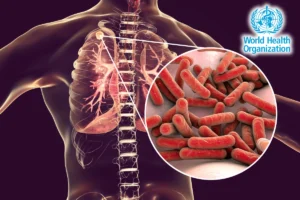
Early in 2021, clinicians at Yale informed Dr. Michael Ombrello, an investigator at the National Institutes of Health, about a patient who had a unique genetic mutation—the first instance of its sort ever observed. Ombrello, an expert in uncommon inflammatory and immunological disorders, was alarmed by the results of initial genetic testing, which revealed a debilitating mutation in a gene called PLCG2 that is essential for healthy immune functioning. It was difficult to understand how the patient, a woman in her forty-eighties, had managed to avoid life-threatening infections for so long. The unexpected onset of significant joint pain and swelling she was experiencing after years of great health was even more perplexing. In order to personally examine her case, he made the decision to bring her to the N.I.H. campus in Bethesda, Maryland.
The Starting Of My Story

That is how, on a pleasant, balmy day in April 2021, right when the cherry blossoms in the Washington region were in full bloom, I found myself a patient at his clinic. I am accustomed to undertaking research because I am both a historian and a biographer. I look for patterns and insights in the lives of others. I was the research subject that spring. Ombrello’s team collected twenty-one vials of my blood from the N.I.H. and kept some of them in liquid nitrogen for later use. Outside of the N.I.H., researchers also started looking into me. Specialists from Yale, Harvard, Columbia and the University of Pennsylvania have looked into my case in recent years, including immunologists, rheumatologists, dermatologists, pulmonologists, and experts in infectious diseases. It has been discussed at powerful conference calls, international medical conferences, and hospital grand rounds. It is covered in PowerPoint presentations.
In one sense, this all makes me fortunate. Too frequently, women who present with difficult-to-diagnose illnesses are advised that their symptoms are unimportant and that their issues are psychological. They spend years visiting various doctors in an effort to find someone—anyone—willing to assist them. My experience has not been like this. Doctors have always taken my situation seriously, perhaps even more so than I did. They dragged me to the top doctors and scientists in the country at the best hospitals. My family and friends were kind and encouraging, and my insurance covered expensive testing and treatments. I was able to continue doing what needed to be done throughout: writing a book, raising a child, and teaching my classes
The Unique Gift
But there is one indisputable reality that is unaffected by anything. Ombrello continues, “You are the only one known to have this precise mutation. “I haven’t seen any reports of this mutation in reference populations, and I haven’t had anyone referred to me or seen anyone with this mutation in my patient cohort.” I am, in other words, a unique individual and a medical curiosity. Before they realize it, doctors frequently say that my condition is “fascinating,” knowing full well that no one truly wants to be fascinating in this sense. But as DNA sequencing technology improves, scientists are better equipped to spot anomalies like me.
They are then left to participate in a process that is somewhat similar to mine as a biographer, trying to grasp life and its significance based on in-depth but imperfect research. Where are we in the grand epic of human history, I’m forced to ask because of my background in history. How do large-scale structural forces, ideas, and technologies influence how people go about living their lives on a daily basis? But getting sick has cemented my place in history more than anything else. The way we get sick—and, occasionally, the way we recover—has everything to do with the luck of the moment, even though illness and death may be the universals of earthly existence.
The Pain and the Drug
Mine has a day when it all started, much like any excellent historical story. I went for a mile-long swim in the Long Island Sound on September 1, 2019, along a little stretch of Connecticut shoreline where distance swimmers frequently congregate. A bizarre underwater plant scratched my forearm after I brushed up against it a few minutes in, leaving me with painful welts that eventually went away an hour later. That evening, my ankles began to itch—really itch, the type of itch that obliterates all rational thought. The following day, I could hardly bend my neck or open my jaw, and a rash that resembled a hive started moving up my calves and legs. The rash moved north up my trunk and arms the following week, while the pain in my neck and jaw migrated south into my arms and shoulders.
I assumed that since I’ve always been healthy, these were only minor inconveniences that that peculiar herb might have brought on. At first, my doctors had much the same thoughts. I receive my healthcare as a professor at Yale through the university’s health facility, a for-profit haven of socialized medicine for staff, teachers, and students. After experiencing increased symptoms for five or six days, I sought an appointment with an advanced-practice registered nurse. She referred me to a dermatologist and advised me that things would get better in a few weeks after prescribing a steroid cream.
The cream worked as intended; the rash vanished completely. However, the joint pain persisted and only got worse with time. It eventually spread to my hands, ankles, and knees and was frequently followed by significant swelling. I was unable to lift my arms above my head as the irritation spread to my shoulders without yelping in agony. When it came to a knee, I appeared to have aged thirty years in a single day, a clumsy old woman intimidated by a set of stairs. It came to my hand, and all of a sudden I had a thick, bloated paw.
My face grew a little puffier, and I put on around ten pounds. After having been solid for a lifetime, my lower teeth began to chip. These changes upset me, but they were insignificant in light of the possibility of living without prednisone. I could function pretty well on a high enough dose; once, I even played basketball with a group of young men. However, if the level fell too low, ordinary tasks like bending over to eat, lifting one’s arms, or bending their knees became impossible.
After a few months
I started keeping track of my symptoms and sensations in an effort to find information that may help me escape the steroid cycle. I made an effort to be scientific, recording dosage, symptoms, and environmental factors like food intake, physical activity, and weather. However, I mostly grumbled. The words “oof,” “omg painful,” “can barely move,” and “this sucks” were among the entries; they accurately captured my mental state but lacked literary brilliance. There were times when things appeared to be getting better, sometimes several days in a row. “Hooray. Gratitude + joy,” I wrote in February 2020, after a largely pain-free day. Inevitably, though, the highs turned low. Even a single day could bring wild variation. “Bad in the morn,” I wrote on January 14th. “Felt stoic + accepting midday. Eve is kinda miserable but has been worse.”
It didn’t help that the covid-19 outbreak started in spring. I belonged to that group of “immunocompromised” Americans who were not permitted to visit the grocery store or give pals hugs because I took potent immune suppressants. Covid limitations also gave me the ability to cover up some of my physical ups and downs. The medicine cycle was so depressing and monotonous that I was afraid of boring my son, partner, and a few close friends by going into too much detail. I tried to be my own testimony instead. In my journal, I noted, “For the record: I will try my best with this, and I will persevere over these coming months in the hope that we can stabilize the situation and find some respite. But if this lasts for the next 30 or 40 years, I’m not sure I’m ready. I retain the right to withdraw.
The Reason For My Fate
I also pondered for hours what I might have done to merit my fate: Was the bourbon too much? cigarettes I smoked while I was a student? My erratic dedication to yoga My divorce’s stress? This, according to my rheumatologist, is typical of the self-blame she sees frequently in her female patients. Her male patients, meanwhile, merely show up and say, “Fix me.” The truth, though, was that she could not fix me. So in the summer of 2020, with her blessing, I went in search of a second opinion.
At a time when the covid vaccine was meant to go into mass manufacturing and rescue us all, this was a worrying finding to make. However, the blood tests did not lie: they revealed that I had the immunological condition known as common variable immune deficiency (cvid), a catch-all name for patients with low antibody levels and a subpar response to vaccination. Contrary to what its name might imply, cvid only affects up to one in every 25,000 people. The medical school adage “When you hear hoofbeats, think horses, not zebras” advises diagnosticians in training to think first of the most typical scenarios. Advocates for cvid patients jokingly refer to themselves as “zebras.”
The Revelation
I was a zebra, but what kind of one? My tests revealed the typical symptoms of cvid, such as a deficiency in B cells, which are the type of white blood cells that produce antibodies. This, in turn, led to low levels of immunoglobulin G (IgG), the main class of antibodies that react to infection. The diagnosis did not, however, match the patient any more precisely than rheumatoid arthritis had. Those with cvid typically have a history of recurrent infections that are difficult to treat. To everyone’s knowledge, I did not. Additionally, my immunoglobulins were out of balance; while my IgG level was low, my IgM level was greater than three times normal.
After then, it was unclear how any of this related to my actual symptoms, which included the pain and swelling that had started so quickly in September 2019. My doctors hypothesized that the mycobacteria they found hiding in my lungs might be the cause of reactive arthritis I suffer from. Since many tests look at antibodies, which cvid individuals don’t produce a lot of, it might be challenging to diagnose infections in these patients. The fact that these patients frequently receive infusions of donor antibodies during treatment—I began receiving monthly intravenous IgG infusions in October 2020—complicates matters further because it is impossible to distinguish between the different antibodies.
But at least one significant test still maintained a high level of accuracy. My doctors conducted a round of genetic testing that fall after seeing the worrying immunology results, which identified my unique mutation. We then realized that I was a zebra with polka dots in addition to being a zebra in general.
My First Visit
Visitors to the campus must go via a security station for an ID check and a thorough vehicle search, which is frequently carried out by armed police officers with the help of canines. The buildings are denoted with numerals in the chronological order of their construction. I mumbled to the security officers that I was there as a patient—you know, for medical research—when I got there for my first visit in April 2021. They said, “Oh, you’re Building 10.”
The largest hospital in the world dedicated completely to clinical research is located in Building 10, also known as the N.I.H.’s Clinical Center.
Patients must typically have a rare or refractory disease—basically, one that is resistant to standard therapy and is thus of medical interest—in order to be invited in. A Clinical Center guide states that they should also have a disease that is “national and worldwide relevance” and has the capability of revealing significant information about how the human body functions. While N.I.H. researchers study a variety of ailments, including widespread issues like cancer, diabetes, and alcoholism, many of them concentrate on ailments that affect only a small number of people and hence receive little attention from the commercial sector. The entire cost is borne by the federal government. Patients are not charged for therapy, and the majority of researchers do not submit applications for outside grants.
The Night
I spent the night at the Edmond J. Safra Family Lodge (Building 65), a Holiday Inn and assisted-living facility combined, a few hundred yards from the Clinical Center, like many N.I.H. patients do. The accommodations have typical hotel amenities including decent beds and a small television with basic cable. Support bars and emergency alert systems are also included. The number of outpatient visits to the Clinical Center decreased from about 100,000 in the pre-covid era to about 70,000 in 2021. An additional 3,000 patients were admitted to the on-site hospital, where they spent an average of 9.4 days. Ombrello is the team leader and has invited sixteen patients to Bethesda for in-person meetings as they work on my case.
I had to go through a formal registration process before my visit, signing document after document, and transferring my medical records to the federal government. After a quick assessment of my vital signs, I continued to do phlebotomy to give those twenty-one vials of blood. Separate from the research facilities used by the investigators, the Clinical Center has a separate lab on the property. One of the primary strategic benefits of the centre is supposedly the fact that everyone who works there does so under one roof, including bench researchers and clinical staff as well as scientists and patients. I moved on to the ninth floor after phlebotomy so that a member of Ombrello’s staff could take a thorough case history. A few hours later, Ombrello and another researcher showed up.
Ombrello might be confused for a graduate student if it weren’t for his white lab coat, his staff’s respect, and his enthusiasm to speak business. He came to the N.I.H. to research a rare disorder called systemic juvenile idiopathic arthritis, also referred to as Still’s disease and marked by recurring fevers, inflammation of the joints and organs, and a characteristic skin rash.
Shortly after he came, a different researcher reported a family that had yet-to-be-identified inflammatory disorders; its members experienced odd illnesses, swelling, and a rash that appeared in response to cold exposure. A PLCG2 mutation that disrupted the immune system at low temperatures was discovered through genetic testing. The novel condition was given the name plaid (for PLCG2-associated antibody deficiency and immune dysregulation) by Ombrello and his associates, who also published their research in The New England Journal of Medicine. With it, Ombrello was recognized as an authority on PLCG2 mutations and started getting recommendations.
My First Interaction
Our initial interaction was primarily a conversation. I described what happened. We discussed the aspects of my scenario that stand out, such as the elevated IgM, the peculiar pattern of symptoms, and of course, my unique mutation. Ombrello informed me that first day, “When I said we’ve known about you for a while, I wasn’t kidding. “At this point, we’ve actually created and tested the mutation that you have in the lab.” He then pulled out his phone to display a two-line graph to me. One showed the typical PLCG2 gene activity by rising strongly and then levelling down. My line followed, which was pancake-flat from beginning to end. Ombrello claims that I have a serious “truncating” mutation that results in the complete loss of function of one copy of the gene. Only two other people in his study’s about eighty participants had a similarly severe loss of function, and even among the three of us, the specifics varied greatly.
When skilled investigators are constructing your one peculiar gene, it’s difficult to feel unimportant. One of Ombrello’s team members informed me during a visit that “your cells are gold to us.” The Clinical Center makes an effort to support this sense of mission. A screen in the lobby reads, “A Researcher’s most important discovery might be you!” According to Gilman, the director of the Clinical Center, “I think it’s impossible to envision making a bigger contribution at the end of life, whether it’s a young man or woman on the battlefield or whether it’s one of our patients in the clinical trials.” Participants in research studies don’t like to hear that the benefits will manifest later, possibly decades after they pass away. However, this type of study is inherently lengthy and tiresome; it involves incremental advancements and numerous failures rather than a single, game-changing solution.
The Unknown illness
My illness hasn’t even been given a name yet. There have been some successful failures of well-informed trials, each with its own cycle of hope and disappointment. I started taking antibiotics for a year after my first visit to the N.I.H. in the hopes that they would treat my joint pain and swelling in addition to killing the mycobacteria that had become trapped in my lungs. I tested positive for exposure to the germs that cause Lyme disease at a subsequent appointment this past spring, necessitating a month of oral medications and then two weeks of intravenous treatment. None of these endeavors produced the anticipated outcomes. I was mostly discouraged and nauseous afterward.
Our most recent test involves the use of the immunosuppressant rapamycin, which is typically administered to kidney transplant patients. Although there haven’t been any notable advancements to date, there may be at least one benefit to this particular medication. Rapamycin is thought to provide anti-aging benefits among fitness enthusiasts. I’ve been feeling distinctly middle-aged for years, but suddenly I’m drinking from a drug-induced spring of youth.
Ombrello finds treating an unusual case like mine to be both fascinating and difficult at the same time. “If you think about people who are referred to the N.I.H., either you have something that someone is specifically interested in—a disease or a mutation—or you have something that has perplexed everyone you’ve come into contact with, and you’ve received a referral to come here as the last centre of hope. We are therefore a pillar of hope, he claims. However, we can’t always provide what people are hoping for.
For the time being, all he can offer is a study report that summarises an analysis of 76 patients with 60 different PLCG2 mutations. My set of one is not always helpful for such purposes; professional journals typically want the overall picture rather than the peculiar individual example. Despite this, it appears that the modern era of genetic testing is creating an endless stream of unique mutations, the majority of which are referred to in medicine as “variants of unknown significance.” We’re dealing with a fire hydrant, Ombrello declares while spewing forth enormous and insurmountable amounts of data. This could eventually lead to a renaissance in customized treatment, allowing for the fine-tuning and boutique editing of each patient’s genes. But for now, we are a long way off from there.
My doctors are pushing forward with their own studies at Yale. My story was condensed into a presentation for the global Clinical Immunology Society by Dr. Mehek Mehta, an allergy and immunology fellow, in the fall. She started with “Cool Breezy Labor Day Weekend, 9/2019,” as she put it on one PowerPoint slide, and ended with what little is known about my PLCG2 mutation. Despite the collective intelligence, she left empty-handed. In a recent conversation, she added, “We don’t have any answers for you. Which is the least satisfying aspect, she said. Dr. Junghee Shin, her boss, is also perplexed. She describes my genetic mutation as “extremely novel,” which is challenging. “So nobody really knows what would be the best way to treat it.” Like Ombrello, Shin has studied my cells in her lab, hoping to figure out the relationship between arthritis, immune deficiency, and genetic mutation.
Am I well Or Ill
It has been challenging to establish a narrative about my current state—am I well or ill—without having any solid information to go on. Is my condition concerning or only amusing? Practically, I can get by on adequate prednisone doses and go about my life without giving my medical condition too much concern. The worst-case scenario is that I will remain in this condition for years, going about my daily activities as my bones begin to deteriorate, my blood sugar levels rise, and my eyes develop cataracts. I probably would have found myself in the same predicament forty years ago, needing prednisone to get through each day. In that regard, all the exams and consultations, prodding and prodding, federal resources, and great medical wonders of the twenty-first century haven’t really made much of a difference.
However, what the tests have shown—namely, that I have a peculiar gene with its own agenda—cannot be undone. The “retrospectoscope,” in which patients and doctors read past symptoms through the lens of current information, is something Ombrello says he strives to avoid.
This mistake, also known as presentism, occurs when historians read modern attitudes into the past. I haven’t been able to stop thinking in this way, for better or worse. What else might it explain if the mutation was present from the beginning, throwing my immune system off balance, including my overactive and anxious nervous system, the fierce muscle tension I battled for years, and my enduring aversion to working late into the night? However, how could I go so long without learning about it? Dr. Shin once remarked that it’s possible that I’ve always been sicker than I thought, and that my normal baseline for pain, weariness, and discomfort may actually be very different from what other people experience. “You might be a very tough person,” she offered, a narrative that I’d be happy to embrace, were it not for the impossibility of ever knowing for sure one way or another.
“For me, that is the conclusion I wish to assist others in reaching.” Perhaps not precisely what Truman had in mind when he dedicated the Clinical Center more than 70 years ago, such a sober evaluation. But the notion seems appropriate for our day, when expectations have been lowered when failure and discovery cohabit so frequently, and when we have just learned enough to grasp everything that we do not yet know and may never know.
To read more such news, download Bharat Express news apps





















